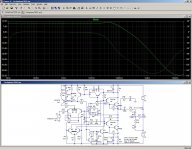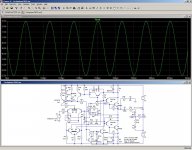Linearizing a transformer is not that difficult, with modern topologies and components.
I gave a (low power) example here: http://www.diyaudio.com/forums/solid-state/177520-opamp-transformer-headphone-amp.html#post2370288
I even tried a similar scheme, in reality and in much more difficult conditions, with a tube stage.
Here is an example with a "normal" amplifier used to drive a transformer, with the main feedback taken downstream, and the compensation taken upstream, with gain and frequency responses grossly equalized.
This is the result of quick and approximate mental calculations, and it doesn't include magnetic non-linearities in contrast with the previous example, but it works, and the frequency response is reasonably flat.
It assumes a poor quality autotransformer having a voltage ratio of 3, designed to handle frequencies of 3KHz+.
Note that the Xover has to protect the amplifier/transformer against low frequencies: here, the frequency response extends to less than 10Hz, but of course it demands a totally unacceptable magnetizing current from the amplifier, and anyway the transformer would be saturated at tiny voltage levels.
The Circlophone used in this example is well behaved, and can in fact drive loads lower than 0.5ohm by itself, without the help of any transformer, but almost any class AB amplifier could be made to work in this way.
The compensation is a kind of TMC around the transformer.
With proper transistors, and provided the output power is not too high, a Circlophone could happily handle loads well under 1 ohm.
An example, actually tested with BD249 is shown here:
http://www.diyaudio.com/forums/solid-state/189599-my-little-cheap-circlophone-25.html#post2698812
With low voltage/high current transistors like the the MJ14003, a realistic 200W/0.5Ω amplifier could be made.
That's about the absolute maximum power reasonably attainable with a Circlophone: it is advantageous with a single pair of output transistors, because multiple pairs require balancing resistors, and this would degrade the linearity and capability to drive extra low loads efficiently.
I gave a (low power) example here: http://www.diyaudio.com/forums/solid-state/177520-opamp-transformer-headphone-amp.html#post2370288
I even tried a similar scheme, in reality and in much more difficult conditions, with a tube stage.
Here is an example with a "normal" amplifier used to drive a transformer, with the main feedback taken downstream, and the compensation taken upstream, with gain and frequency responses grossly equalized.
This is the result of quick and approximate mental calculations, and it doesn't include magnetic non-linearities in contrast with the previous example, but it works, and the frequency response is reasonably flat.
It assumes a poor quality autotransformer having a voltage ratio of 3, designed to handle frequencies of 3KHz+.
Note that the Xover has to protect the amplifier/transformer against low frequencies: here, the frequency response extends to less than 10Hz, but of course it demands a totally unacceptable magnetizing current from the amplifier, and anyway the transformer would be saturated at tiny voltage levels.
The Circlophone used in this example is well behaved, and can in fact drive loads lower than 0.5ohm by itself, without the help of any transformer, but almost any class AB amplifier could be made to work in this way.
The compensation is a kind of TMC around the transformer.
With proper transistors, and provided the output power is not too high, a Circlophone could happily handle loads well under 1 ohm.
An example, actually tested with BD249 is shown here:
http://www.diyaudio.com/forums/solid-state/189599-my-little-cheap-circlophone-25.html#post2698812
With low voltage/high current transistors like the the MJ14003, a realistic 200W/0.5Ω amplifier could be made.
That's about the absolute maximum power reasonably attainable with a Circlophone: it is advantageous with a single pair of output transistors, because multiple pairs require balancing resistors, and this would degrade the linearity and capability to drive extra low loads efficiently.
Attachments
That plot of freq resp does not show <10Hz.
I would guess that the 4Hz to 100kHz bandwidth is ~=+0dB,-28dB.
That is atrocious.
The 30Hz to 3kHz +0db, -0.1dB would make your autotransformer a good mid range driver.
Just the point I was making.
Your conclusion that a few back of the fag packet guesses is flawed, it does not show it is easy to design and develop a good wideband audio transformer.
I would guess that the 4Hz to 100kHz bandwidth is ~=+0dB,-28dB.
That is atrocious.
The 30Hz to 3kHz +0db, -0.1dB would make your autotransformer a good mid range driver.
Just the point I was making.
Your conclusion that a few back of the fag packet guesses is flawed, it does not show it is easy to design and develop a good wideband audio transformer.
Last edited:
Probably a good idea to examine carefully the material provided before rushing to (erroneous) conclusions and indulging in unjustified criticism, this could save some embarrassment.That plot of freq resp does not show <10Hz.
I would guess that the 4Hz to 100kHz bandwidth is ~=+0dB,-28dB.
That is atrocious.
The 30Hz to 3kHz +0db, -0.1dB would make your autotransformer a good mid range driver.
Just the point I was making.
Your conclusion that a few back of the fag packet guesses is flawed, it does not show it is easy to design and develop a good wideband audio transformer.
a ribbon driver is presumably not a heavily frequency dependent load - typically these are dominated by the real Resistance term to way beyond audio
1 Ohm is not a particularly hard load for SS, either BJT or MOSFET
if the needed power is < ~50 W then only 10 A, 10 V peak are required - quite easy even if not well matched by "classic" audio output Q which handle much higher V
this would be a fine range for op amp + output current buffer Q but you probably won’t find a existing diy audio amplifier design with any history for such a odd load
1 Ohm is not a particularly hard load for SS, either BJT or MOSFET
if the needed power is < ~50 W then only 10 A, 10 V peak are required - quite easy even if not well matched by "classic" audio output Q which handle much higher V
this would be a fine range for op amp + output current buffer Q but you probably won’t find a existing diy audio amplifier design with any history for such a odd load
Add 10-18 db for peaks over the avg watt number. i'm not convinced that adding a transformer is the way to go, adding miles of wire before the driver  convenient .. yes, best ..no ..!
convenient .. yes, best ..no ..!
Best to direct drive the ribbon, with it's own dedicated amplfier, you will need more than 50 watts IMO for dynamics.
Best to direct drive the ribbon, with it's own dedicated amplfier, you will need more than 50 watts IMO for dynamics.
Last edited:
- Status
- This old topic is closed. If you want to reopen this topic, contact a moderator using the "Report Post" button.

